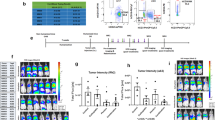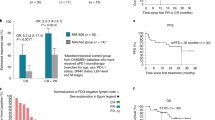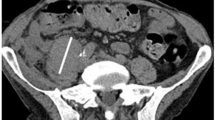Abstract
Background: Systemic IL-2 has shown some activity in metastatic melanoma, but its use is severely limited by toxicity. TG2001 is a product in which the human IL-2 cDNA was incorporated into the genome of Vero cells, a monkey fibroblast cell line. The goal of this intratumorally applied therapy was to create an antitumor immune response stimulated by xeno-antigens and local production of IL-2 in the close vicinity of tumor-specific antigens. TG2001 was reported to have a good safety profile in two previous dose-escalating phase I studies performed in 18 patients with various solid tumors, with encouraging clinical responses in three patients. The objectives of this study were to evaluate the tolerance and incidence of tumor regression in patients with metastatic melanoma, following repeated administration of Vero-IL-2 cells. Patients and methods: This was on open-label, randomized phase II study comparing two doses of Vero-IL-2, 5×105 and 5×106 cells. Twenty-eight patients with metastatic melanoma were enrolled in the study, 14 in each treatment group. Patients received TG2001 by intratumoral injection on days 1, 3, and 5 every 4 weeks for four cycles, and every 8 weeks thereafter, until evidence of progressive disease (PD). Criteria for patient selection included histologically proven metastatic melanoma, with one tumor accessible for product administration, and at least another tumor site for response assessment. Evaluation included tumor measurements, humoral and T cell–mediated local and systemic immune response, humoral response to Vero cells, adverse events and standard laboratory parameters. Results: None of the patients achieved a confirmed objective response. Stable disease (SD) was seen in six (43%) and eight patients (57%) at the 5×105 and the 5×106 dose level, respectively. Two patients, one in each group, died during the study (i.e., within 1 month after the last injection) due to PD. Three patients exhibited antibody responses to Vero cells. T-cell immunity, serum cytokine levels and cytokine mRNA expression in tumor biopsies did not show meaningful alterations after therapy, except for a trend toward an increase in intratumoral TH2 cytokine (IL-4 and/or IL-10) levels. The study drug was well tolerated at both dose levels and side effects mainly consisted of injection site pain and erythema, and pyrexia. Conclusion: The intratumoral administration of TG2001 was generally well tolerated in patients with metastatic melanoma, and transient disease stabilization was observed in 50% of patients.
This is a preview of subscription content, access via your institution
Access options
Subscribe to this journal
Receive 12 print issues and online access
$259.00 per year
only $21.58 per issue
Buy this article
- Purchase on Springer Link
- Instant access to full article PDF
Prices may be subject to local taxes which are calculated during checkout
Similar content being viewed by others
References
Tepper RI, Pattengale PK, Leder P . Murine interleukin-4 displays potent antitumor activity in vivo Cell 1989 57: 503–512
Gansbacher B, Bannerji R, Daniels B, Zier K, Cronin K, Gilboa E . Retroviral vector-mediated gamma-interferon gene transfer into tumor cells generates potent and long lasting antitumor immunity Cancer Res 1990 50: 7820–7825
Gansbacher B, Zier K, Daniels B, Cronin K, Bannerji R, Gilboa E . Interleukin 2 gene transfer into tumor cells abrogates tumorigenicity and induces protective immunity J Exp Med 1990 172: 1217–1224
Fearon ER, Pardoll DM, Itaya T et al. Interleukin-2 production by tumor cells bypasses T helper function in the generation of an antitumor response Cell 1990 60: 397–403
Golumbek PT, Lazenby AJ, Levitsky HI et al. Treatment of established renal cancer by tumor cells engineered to secrete interleukin-4 Science 1991 254: 713–716
Dranoff G, Jaffee E, Lazenby A et al. Vaccination with irradiated tumor cells engineered to secrete murine granulocyte–macrophage colony-stimulating factor stimulates potent, specific, long-lasting anti-tumor immunity Proc Natl Acad Sci USA 1993 90: 3539–3543
Roth C, Rochlitz C, Kourilsky P . Immune response against tumors Adv Immunol 1994 57: 281–351
Parmiani G, Rodolfo M, Melani C . Immunological gene therapy with ex vivo gene-modified tumor cells: a critique and a reappraisal Hum Gene Ther 2000 11: 1269–1275
Roth C, Mir LM, Cressent M et al. Inhibition of tumor growth by histoincompatible cells expressing interleukin-2 Int Immunol 1992 4: 1429–1436
Quintin-Colonna F, Devauchelle P, Fradelizi D et al. Gene therapy of spontaneous canine melanoma and feline fibrosarcoma by intratumoral administration of histoincompatible cells expressing human interleukin-2 Gene Ther 1996 3: 1104–1112
Rochlitz C, Jantscheff P, Bongartz G et al. Gene therapy study of cytokine-transfected xenogeneic cells (Vero-interleukin-2) in patients with metastatic solid tumors Cancer Gene Ther 1999 6: 271–281
Tartour E, Mehtali M, Sastre-Garau X et al. Phase I clinical trial with IL-2–transfected xenogeneic cells administered in subcutaneous metastatic tumours: clinical and immunological findings Br J Cancer 2000 83: 1454–1461
Boulay JL, Perruchoud AP, Reuter J, Bolliger C, Herrmann R, Rochlitz C . P21 gene expression as an indicator for the activity of adenovirus-p53 gene therapy in non-small cell lung cancer patients Cancer Gene Ther 2000 7: 1215–1219
Moller P, Moller H, Sun Y et al. Increased non-major histocompatibility complex-restricted lytic activity in melanoma patients vaccinated with cytokine gene-transfected autologous tumor cells Cancer Gene Ther 2000 7: 976–984
Chang AE, Li Q, Bishop DK, Normolle DP, Redman BD, Nickoloff BJ . Immunogenetic therapy of human melanoma utilizing autologous tumor cells transduced to secrete granulocyte–macrophage colony-stimulating factor Hum Gene Ther 2000 11: 839–850
Arienti F, Belli F, Napolitano F et al. Vaccination of melanoma patients with interleukin 4 gene-transduced allogeneic melanoma cells Hum Gene Ther 1999 10: 2907–2916
Palmer K, Moore J, Everard M et al. Gene therapy with autologous, interleukin 2–secreting tumor cells in patients with malignant melanoma Hum Gene Ther 1999 10: 1261–1268
Brenner MK, Heslop H, Krance R et al. Phase I study of chemokine and cytokine gene-modified autologous neuroblastoma cells for treatment of relapsed/refractory neuroblastoma using an adenoviral vector Hum Gene Ther 2000 11: 1477–1488
Bowman L, Grossmann M, Rill D et al. IL-2 adenovector-transduced autologous tumor cells induce antitumor immune responses in patients with neuroblastoma Blood 1998 92: 1941–1949
Bowman LC, Grossmann M, Rill D et al. Interleukin-2 gene-modified allogeneic tumor cells for treatment of relapsed neuroblastoma Hum Gene Ther 1998 9: 1303–1311
Tani K, Nakazaki Y, Hase H et al. Progress reports on immune gene therapy for stage IV renal cell cancer using lethally irradiated granulocyte–macrophage colony-stimulating factor–transduced autologous renal cancer cells Cancer Chemother Pharmacol 2000 46: S73–S76
Simons JW, Mikhak B, Chang JF et al. Induction of immunity to prostate cancer antigens: results of a clinical trial of vaccination with irradiated autologous prostate tumor cells engineered to secrete granulocyte–macrophage colony-stimulating factor using ex vivo gene transfer Cancer Res 1999 59: 5160–5168
Trudel S, Li Z, Dodgson C et al. Adenovector engineered interleukin-2 expressing autologous plasma cell vaccination after high-dose chemotherapy for multiple myeloma — a phase 1 study Leukemia 2001 15: 846–854
Okada H, Pollack IF, Lieberman F et al. Gene therapy of malignant gliomas: a pilot study of vaccination with irradiated autologous glioma and dendritic cells admixed with IL-4 transduced fibroblasts to elicit an immune response Hum Gene Ther 2001 12: 575–595
Okada H, Pollack IF, Lotze MT et al. Gene therapy of malignant gliomas: a phase I study of IL-4-HSV-TK gene-modified autologous tumor to elicit an immune response Hum Gene Ther 2000 11: 637–653
Sobol RE, Royston I, Fakhrai H et al. Injection of colon carcinoma patients with autologous irradiated tumor cells and fibroblasts genetically modified to secrete interleukin-2 (IL-2): a phase I study Hum Gene Ther 1995 6: 195–204
Crowley NJ, Slingluff CL Jr, Darrow TL, Seigler HF . Generation of human autologous melanoma-specific cytotoxic T-cells using HLA-A2–matched allogeneic melanomas Cancer Res 1990 50: 492–498
Arienti F, Sule-Suso J, Melani C et al. Interleukin-2 gene-transduced human melanoma cells efficiently stimulate MHC-unrestricted and MHC-restricted autologous lymphocytes Hum Gene Ther 1994 5: 1139–1150
Imro MA, Dellabona P, Manici S et al. Human melanoma cells transfected with the B7-2 co-stimulatory molecule induce tumor-specific CD8+ cytotoxic T lymphocytes in vitro Hum Gene Ther 1998 9: 1335–1344
Thomas MC, Greten TF, Pardoll DM, Jaffee EM . Enhanced tumor protection by granulocyte–macrophage colony-stimulating factor expression at the site of an allogeneic vaccine Hum Gene Ther 1998 9: 835–843
Huang AY, Golumbek P, Ahmadzadeh M, Jaffee E, Pardoll D, Levitsky H . Role of bone marrow–derived cells in presenting MHC class I–restricted tumor antigens Science 1994 264: 961–965
Campbell I, Moyana T, Carlsen S, Zheng C, Xiang J . Adenoviral transfer of xenogeneic MHC class I gene results in loss of tumorigenicity and inhibition of tumor growth Cancer Gene Ther 2000 7: 37–44
Allione A, Consalvo M, Nanni P et al. Immunizing and curative potential of replicating and nonreplicating murine mammary adenocarcinoma cells engineered with interleukin (IL)-2, IL-4, IL-6, IL-7, IL-10, tumor necrosis factor alpha, granulocyte–macrophage colony-stimulating factor, and gamma-interferon gene or admixed with conventional adjuvants Cancer Res 1994 54: 6022–6026
Rodolfo M, Zilocchi C, Melani C et al. Immunotherapy of experimental metastases by vaccination with interleukin gene-transduced adenocarcinoma cells sharing tumor-associated antigens. Comparison between IL-12 and IL-2 gene–transduced tumor cell vaccines J Immunol 1996 157: 5536–5542
Melero I, Mazzolini G, Narvaiza I, Qian C, Chen L, Prieto J . IL-12 gene therapy for cancer: in synergy with other immunotherapies Trends Immunol 2001 22: 113–115
Schmidt W, Schweighoffer T, Herbst E et al. Cancer vaccines: the interleukin 2 dosage effect Proc Natl Acad Sci USA 1995 92: 4711–4714
Aruga A, Aruga E, Tanigawa K, Bishop DK, Sondak VK, Chang AE . Type 1 versus type 2 cytokine release by Vbeta T cell subpopulations determines in vivo antitumor reactivity: IL-10 mediates a suppressive role J Immunol 1997 159: 664–673
Song K, Chang Y, Prud'homme GJ . Regulation of T-helper-1 versus T-helper-2 activity and enhancement of tumor immunity by combined DNA-based vaccination and nonviral cytokine gene transfer Gene Ther 2000 7: 481–492
Tagawa M . Cytokine therapy for cancer Curr Pharm Des 2000 6: 681–699
Marchand M, van Baren N, Weynants P et al. Tumor regressions observed in patients with metastatic melanoma treated with an antigenic peptide encoded by gene MAGE-3 and presented by HLA-A1 Int J Cancer 1999 80: 219–230
Nestle FO, Alijagic S, Gilliet M et al. Vaccination of melanoma patients with peptide- or tumor lysate-pulsed dendritic cells Nat Med 1998 4: 328–332
Rosenberg SA, Yang JC, Schwartzentruber DJ et al. Immunologic and therapeutic evaluation of a synthetic peptide vaccine for the treatment of patients with metastatic melanoma Nat Med 1998 4: 321–327
Author information
Authors and Affiliations
Corresponding author
Rights and permissions
About this article
Cite this article
Rochlitz, C., Dreno, B., Jantscheff, P. et al. Immunotherapy of metastatic melanoma by intratumoral injections of Vero cells producing human IL-2: Phase II randomized study comparing two dose levels. Cancer Gene Ther 9, 289–295 (2002). https://doi.org/10.1038/sj.cgt.7700441
Received:
Published:
Issue Date:
DOI: https://doi.org/10.1038/sj.cgt.7700441
Keywords
This article is cited by
-
Intratumoral immunotherapy for melanoma
Cancer Immunology, Immunotherapy (2015)
-
Cytokine-enhanced vaccine and suicide gene therapy as surgery adjuvant treatments for spontaneous canine melanoma: 9 years of follow-up
Cancer Gene Therapy (2012)
-
Cytokine-armed vaccinia virus infects the mesothelioma tumor microenvironment to overcome immune tolerance and mediate tumor resolution
Cancer Gene Therapy (2010)
-
Genetically engineered Newcastle disease virus for malignant melanoma therapy
Gene Therapy (2009)
-
Enhancement of Oncolytic Properties of Recombinant Newcastle Disease Virus Through Antagonism of Cellular Innate Immune Responses
Molecular Therapy (2009)



